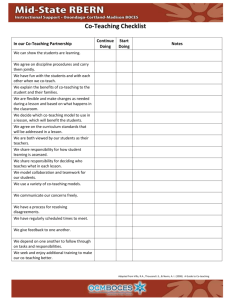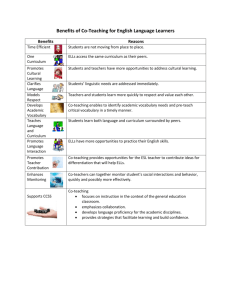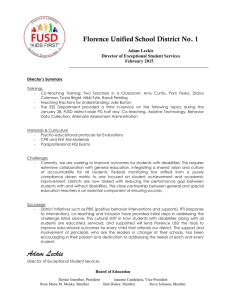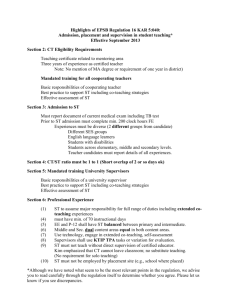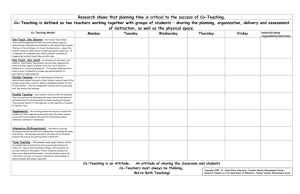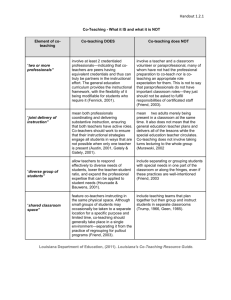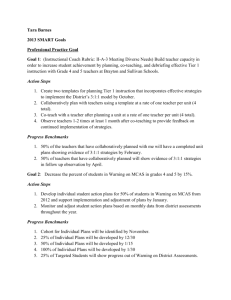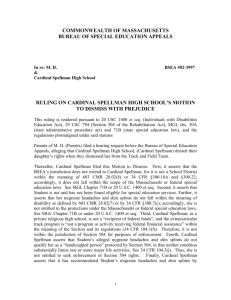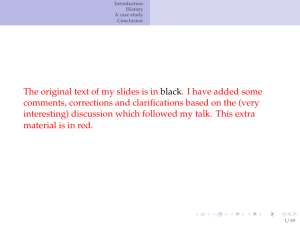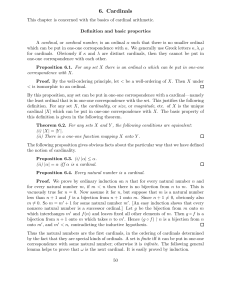7 Effective Schools Correlates, Data ?s, WT ?s, Co
advertisement
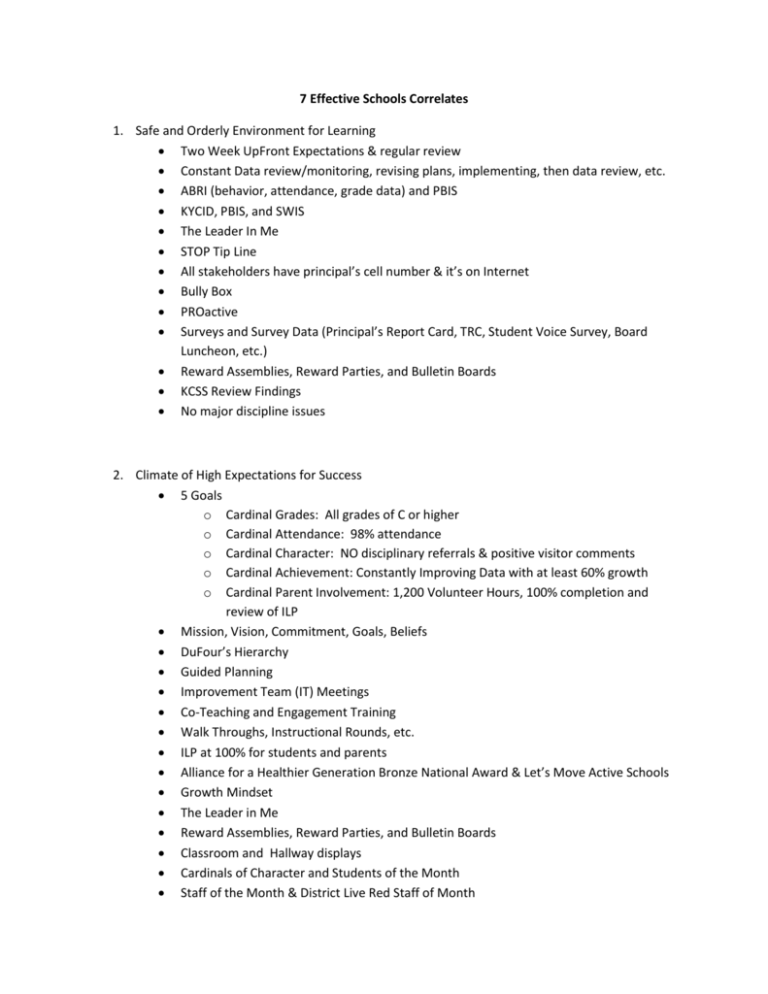
7 Effective Schools Correlates 1. Safe and Orderly Environment for Learning Two Week UpFront Expectations & regular review Constant Data review/monitoring, revising plans, implementing, then data review, etc. ABRI (behavior, attendance, grade data) and PBIS KYCID, PBIS, and SWIS The Leader In Me STOP Tip Line All stakeholders have principal’s cell number & it’s on Internet Bully Box PROactive Surveys and Survey Data (Principal’s Report Card, TRC, Student Voice Survey, Board Luncheon, etc.) Reward Assemblies, Reward Parties, and Bulletin Boards KCSS Review Findings No major discipline issues 2. Climate of High Expectations for Success 5 Goals o Cardinal Grades: All grades of C or higher o Cardinal Attendance: 98% attendance o Cardinal Character: NO disciplinary referrals & positive visitor comments o Cardinal Achievement: Constantly Improving Data with at least 60% growth o Cardinal Parent Involvement: 1,200 Volunteer Hours, 100% completion and review of ILP Mission, Vision, Commitment, Goals, Beliefs DuFour’s Hierarchy Guided Planning Improvement Team (IT) Meetings Co-Teaching and Engagement Training Walk Throughs, Instructional Rounds, etc. ILP at 100% for students and parents Alliance for a Healthier Generation Bronze National Award & Let’s Move Active Schools Growth Mindset The Leader in Me Reward Assemblies, Reward Parties, and Bulletin Boards Classroom and Hallway displays Cardinals of Character and Students of the Month Staff of the Month & District Live Red Staff of Month Use of research based instructional strategies (Learning 360) 3. Instructional Leadership by All PLCs (grade level and departmental meet weekly) Committees SBDM All provide input on budget, schedule, etc. Surveys & Survey Data Cardinals of Character and Students of the Month Staff of the Month 4. Clear and Focused Mission Developed by ALL stakeholders and reviewed annually Mission: At LCMS, our mission is to prepare ALL students for success in the 21st century. Goal: At LCMS, our goal is proficiency and college/career readiness for ALL students. Vision: At LCMS, our vision is for ALL students to become critical thinkers, lifelong learners, and productive members of society. 5. Opportunity to Learn and Student Time on Task Students in Tier 2 are given 45 minutes extra daily Students in Tier 3 are given 45 minutes extra daily and 15 mins 3X per week Students in enrichment are given 45 minutes extra daily Before School (voluntary or mandatory if D or F in class) and After School tutoring daily for one hour Lunch Study Hall (voluntary or mandatory if F in class) Teachers work with students during their planning, lunch, etc. Use Schlecthy’s WOW Framework for student cognitive engagement DuFour’s Hierarchy Co-Teaching Models 6. Frequent Monitoring of Student Progress Universal Screening three times per year RtI Tier 3 monitoring every two weeks; Tier 2 every three weeks; enrichment monthly CIITS Quarterly Learning Checks Assessment Literacy (Feedback and Formative Assessment stressed) Longitudinal Data Tracking for Individuals and district o Use KDE Benchmark Report Data Notebooks for students, goal setting in Agenda and ILP, and student conferences ILP reports 7. Positive Home-School Relations Home Visits PTSO Good News Reports to Board Parent Involvement Activities and PI Log for items done at home Mentoring of students on PtGT Facebook, Twitter communications School Website communications One Calls, Marquee, Announcements, Newspaper, etc. All stakeholders on committees: input invited Surveys and Survey Data Annual ILP Parent Review at 100% for three years in a row Conferences at request parent/student & teachers schedule if needed Bronze National Recognition through Healthy Schools Program Cardinal Parent Involvement GOAL: 1,200 Volunteer Hours, 100% completion and review of ILP 5 DATA QUESTIONS: 1. 2. 3. 4. 5. What does the data tell us? What does the data not tell us? Areas of celebration Areas of concern Next steps WALK-THROUGH QUESTIONS: What are you learning today? Why is that important? How do you know your work is good? Is the feedback that your teacher provides timely and does it help you improve? SIX Co-Teaching Models 1. One Teach, One Observe. One of the advantages in co-teaching is that more detailed observation of students engaged in the learning process can occur. With this approach, for example, co-teachers can decide in advance what types of specific observational information to gather during instruction and can agree on a system for gathering the data. Afterward, the teachers should analyze the information together. 2. One Teach, One Assist. In a second approach to co-teaching, one person would keep primary responsibility for teaching while the other professional circulated through the room providing unobtrusive assistance to students as needed. 3. Parallel Teaching. On occasion, student learning would be greatly facilitated if they just had more supervision by the teacher or more opportunity to respond. In parallel teaching, the teachers are both covering the same information, but they divide the class into two groups and teach simultaneously. 4. Station Teaching. In this co-teaching approach, teachers divide content and students. Each teacher then teaches the content to one group and subsequently repeats the instruction for the other group. If appropriate, a third station could give students an opportunity to work independently. 5. Alternative Teaching: In most class groups, occasions arise in which several students need specialized attention. In alternative teaching, one teacher takes responsibility for the large group while the other works with a smaller group. 6. Team Teaching: In team teaching, both teachers are delivering the same instruction at the same time. Some teachers refer to this as having one brain in two bodies. Others call it tag team teaching. Most coteachers consider this approach the most complex but satisfying way to co-teach, but the approach that is most dependent on teachers' styles.


